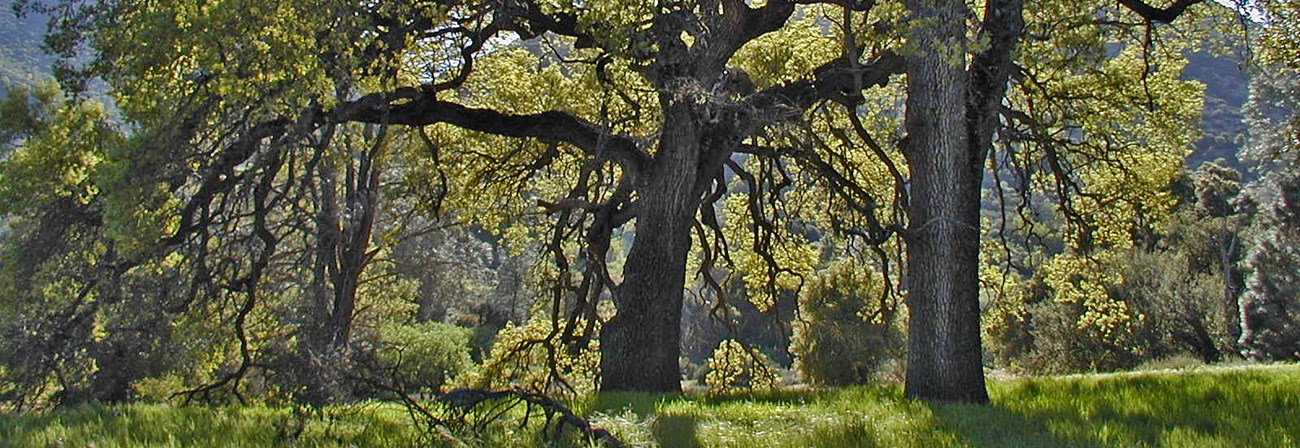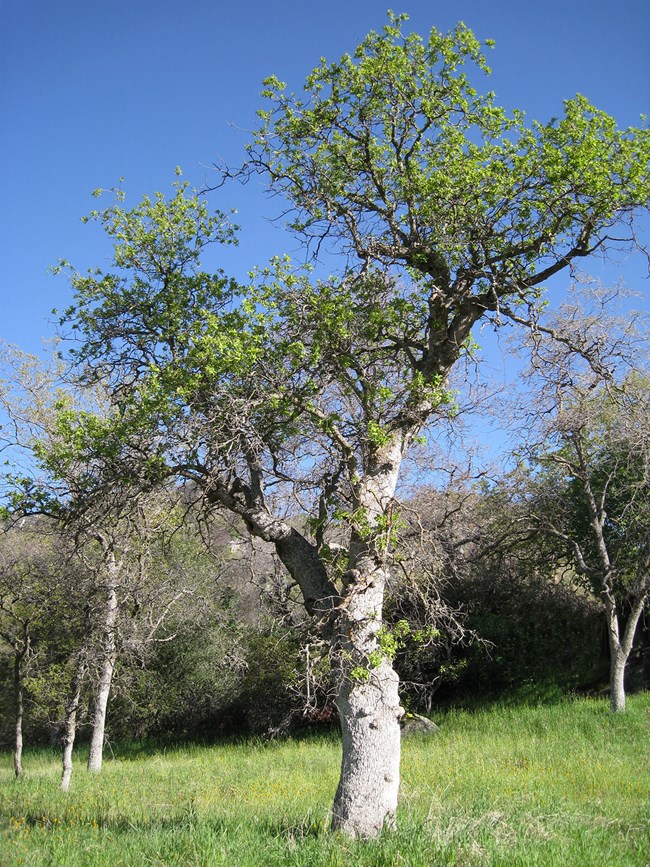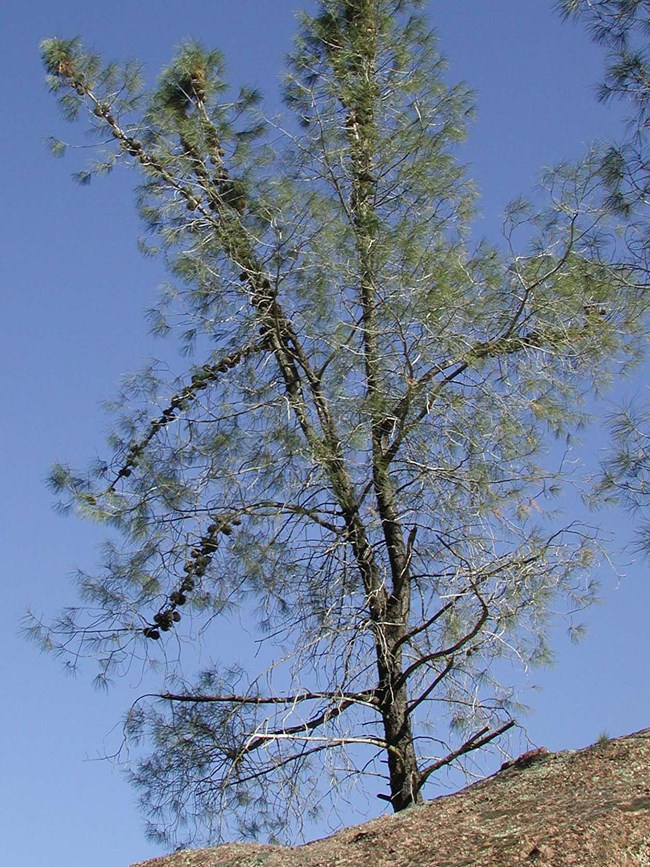
NPS / William Elder
The park is home to numerous tree species and more than 50 species of shrubs. Seven of the more common trees are described below, including trail recommendations for the best viewing opportunities. For help identifying trees in the park, explore the photo gallery of different tree and shrub species that you may encounter during your visit.

NPS OaksThe scientific name for oaks, Quercus, is derived from two Celtic words: - quer meaning fine, and cuez meaning tree. Oaks are indeed fine trees. Branched and spreading, mature trees create an immense crown area. The oaks are unique in producing acorns for fruit. Their catkins (or flower groups) can be either male or female, with both sexes present on the same tree. They rely on the wind to assist in pollination. Oaks have extremely variable foliage, even on the same tree. Each species of tree can hybridize (interbreed) with other species, adding to this effect. This variation can make identification difficult. At Pinnacles, three tree species—valley oak, blue oak and coast live oak —stand out.
Valley OakThis oak may be the largest in North America and is unique to California. As suggested from its name, the valley oak is found primarily in open lowlands and flood plains. Only in these low areas will the valley oak find enough water to thrive. In Pinnacles, you will find this spectacular tree along the Bench Trail. Presence: uncommon. Tree: deciduous, up to 70 feet in height, light grey bark in large square sections. Leaf: deeply lobed, upper surface is shiny and dark green, lower surface is fuzzy dull green.
Blue OakThis is the most common oak found at Pinnacles. Unlike the valley oak which has a high demand for water, the blue oak seeks the arid slopes. Its ability to endure hot temperature and low water allows the blue oak to prosper here. While this oak can be seen on all the park's trails, the High Peaks and Condor Gulch provide the best viewing opportunities. Presence: common. Tree: deciduous, 12 to 40 feet tall, bark is furrowed with thin grey scales. Leaf: blades oblong, margin wavy or smooth, upper surface a dull, bluish green.
Coast Live OakThis oak is the most characteristic tree of California's plains, foothills and valleys. It seldom grows straight and tall, the trunks preferring to lean this way and that. Its long branches twist and turn. Tending to prefer moist riparian areas, it is best seen along the Old Pinnacles, Moses Springs, Juniper Canyon and Bear Gulch Trails. Presence: common. Tree: evergreen, 20 to 50 feet tall, bark furrowed and ridged, dark grey. Leaf: blade is oblong with a toothed margin. Upper surface strongly convex and dull green.

NPS / Angie Lucas Other TreesGray PineThis is the only pine tree found in the park. It has an awkward grace with its crooked, leaning multi-branched trunk. Its soft wood provides the perfect storage place for the acorn woodpecker's stockpile of food. The male cones, located on the tips of lower branches, fill the air with yellow pollen in March and April. Female cones can be seen next to the trunk in the tops of the trees, maturing and dropping from the tree in their second year. They produce a bounty of sweet seeds that were a staple for the Chalone Native Americans. Although the trees have numerous needles, they produce little shade. With the additional fact that their wood is too soft for anything but firewood, the gray pine was not a favorite tree among the settlers of the west. In fact, settlers considered them useless. Their value comes not from their usefulness, but rather their quiet beauty. The gray pine can be seen throughout the park along any of the trails. Found in the valleys, chaparral hillsides, and the mountain tops, they are impossible to miss. Presence: common. Tree: evergreen, 40 to 70 feet in height, bark is dark gray with deep irregular furrows. Fruit: pine nuts produced in cones.California BuckeyeAlthough sometimes disguised as a shrub, the buckeye is one of the common trees in the park. The buckeye is named for its large brown fruits that resembel a buck's eye. To survive the dry Californian summers, buckeyes are summer deciduous - the leaves drop in late June through July and return in February with the rains. By dropping their leaves during the hot dry months, the trees save their resources for the more productive winter and spring months. Their flowers, both beautiful and fragrant, are poisonous to honey bees and are instead pollinated by moths and flies. The seeds you see drooping on the branches from July through November are also poisonous. Native Americans used the ground seed to stun fish for easy capture. Buckeyes favor cool canyons, stream corridors, and moist north facing slopes. They are best seen on the Old Pinnacles, Moses Springs and Bear Gulch Trails. Presence: common. Tree: deciduous, 12 to 25 feet in height, smooth, light gray bark. Leaf: 4 to 7 leaflets spreading out like a hand. Each leaflet with a fine saw-toothed edge. Flower: white to light pink in dense narrow clusters at the end of branch tips. Fruit: large rounded capsule - dark brown.Fremont CottonwoodThe fuzzy cotton-like flowers and seeds are the namesake for this tree. In early spring, the flowers appear on bare branches, the leaves emerging in late spring. Summer finds cottonwoods in full leaf, providing much desired shade. Then, their cotton tufted seeds start floating away on the breeze. Come fall, the light green leaves fade to an opaque yellow and cover the valley floors. Winter finds the trees bare and gray against the sky. Cottonwoods are dependent on a constant supply of water. They have historically lead pioneers to water in arid lands. Due to their assistance in finding water and providing abundant shade, cottonwoods are the most written about tree in literature by early explorers. The cottonwoods at Pinnacles are no different. You will find these trees along our streams. Your best views of cottonwoods are along the Bench and North Wilderness trails. Presence: uncommon. Tree: deciduous, 40 to 80 feet in height, bark smooth and gray for young trees, heavily furrowed on aged trees. Leaf: triangle or heart shaped with fine saw toothed edges. Flowers: male and female catkins (small dangling flower clusters) on separate trees. Fruit: achenes.Western SycamoreUnlike most trees, sycamores have separate male and female trees. They rely upon the wind for pollination. Their majestic trunks branch irregularly, spreading to create large crowns. Sycamores provide large amounts of cool shade on a hot Pinnacles summer day. They shed their leaves in the fall, coating the trails with yellow remnants. Like cottonwoods, sycamores are moisture dependent trees, requiring a consistent source of water. Due to their high water demand, sycamores are only found along two trails in the park: the Bear Gulch and the South Wilderness Trails. Presence: uncommon. Tree: deciduous, 30 to 110 feet in height, bark is smooth, mottled in color, and continuously peeling Leaf: 3 to 5 lobed leaves shaped like a hand. Flowers: small with makes and females separate in round balls Fruit: round balls of small fuzzy seedsSources: A Natural History of western Trees, Peattle, D.C., 1953; The Jepson manual of Higher Plants of California, Hickman, J.C. ed.; Oaks of California, Pavlik, B.M., et al, 1991. Trees and Shrubs Photo Gallery |
Last updated: May 13, 2022
